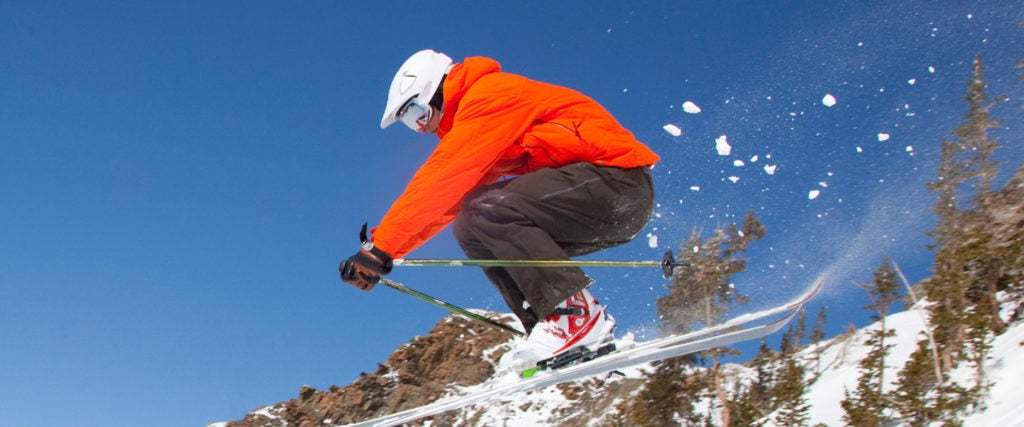It might be hard to appreciate them under their winter coats and snow pants, but professional skiers have incredible bodies for good reason: Skiing is a killer workout. Research shows that skiing is a mix of cardio and resistance training that’s comparable to cycling or rowing workouts that can improve everything from your metabolism to your blood pressure and heart rate. And for my personal purposes, skiing makes having a great ass seem like an inevitability.
Still, having only skied twice as a tween with no knowledge beyond “make a pizza shape with your skis when you want to slow down,” it would be dangerous to break quarantine to just break my leg on the slopes — especially when many hospitals are still operating at full capacity. So I split the difference and tried ski jumping from the comfort of my apartment, much to my dog’s dismay.
Often incorporated as a part of HIIT workouts, ski jump exercises are a “fun and uncomplicated exercise that provides muscle strengthening and the added benefits of improved agility, balance and overall body coordination,” certified personal trainer Brandon Nicholas tells me. “This is perfect for beginners looking to improve or spice up their routines.”
On the surface, ski jumps look like a leg exercise, but Nicholas notes that this “solid and dynamic exercise that impacts the whole body” focuses on the glutes, quadriceps, hamstrings, calves and core muscles. As someone who lives in a studio apartment, being able to workout all these areas without any additional equipment sold me on the ski jump.
There are many tutorials on YouTube about how to master the ski jump exercise, but the way it works is, first, you stand with your legs hip width apart, with a slight bend in your knees and hips. Bending your knees is basic, but bending at the hips can feel less innate — essentially, it means making a straight line with your spine from hip to shoulder when your knees are slightly bent. From there, shift your weight onto one leg while the foot of the other leg is raised from the ground, with the standing leg’s knee bent and your hips lowered slightly.

Then it’s time for the fun part. “Jump explosively off your standing foot to the opposite side of your standing leg and land on the foot initially raised,” Nicholas says. “Bring your initially standing leg toward the other’s ankle without it touching the floor.”

Repeat this on each side until you get the hang of it, and then to increase the range of motion, touch the floor during each jump. According to certified personal trainer Jenny Abouobaia, “The ski jump exercise is great for cardio as well as your butt, so I find that it’s better to time myself with this one rather than counting reps,” she says, recommending three sets of 30 seconds of jumping with 15-second breaks in between.
Make an attempt to increase the intensity and speed with each set, but always prioritizing form for pace. “If you find that your muscles are getting too tired to allow you to perform the exercise correctly, slow down or take a break until you can execute the move with perfect form,” Abouobaia suggests.

Even with breaks in between, the short two minute mini-workout session was far from easy. I tried it in addition to a 30-minute Yoga with Adriene video, along with a 15-minute Madfit ballet session and felt it all in my sturdy base of a body the next two days. The ski jump exercise felt like something in between the chair-pose in yoga and the leaps you take in dance, and it wasn’t just challenging, it was a lot of fun too, and made me grateful I don’t have neighbors living below me.
But does it work for actual skiing? Although I was eager to try out my new skills on the slopes, professional skier and former Olympian Wendy Fisher warns that this exercise is “not describing a ski jump, but how to ski moguls. When you’re ski jumping, you never want to be on your heels. By the way, you never want to be on your heels ever skiing.”
When I showed her a Howcast video on how to do a ski jump (the first result on Google for “ski jump exercise”), Fisher had more to say about how poorly this would translate in reality. For one, “She never describes what type of ski jump she’s training you for. When you say ‘ski jump’ I think of a nordic ski jump. What type of ski jump was she trying to prepare a person for?” Fisher asks. The bottom line, “You can’t teach or demonstrate how to jump or ski on a flat surface. She didn’t incorporate pitch, gravity pull or speed.”
While my hopes of being a ski jumper in real life are crushed, at least I have this new and improved ass to fall back on. That’s always been a better hill to die on anyways.

